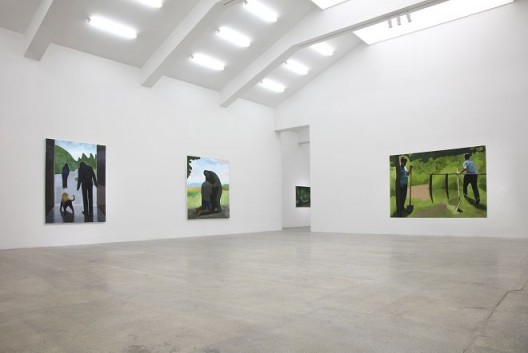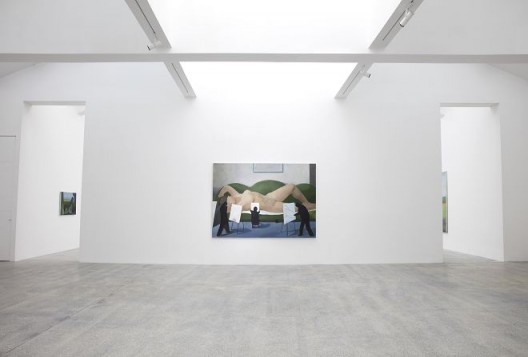Platform China (798 Art Zone, Chaoyang, Beijing), Mar 5–Apr 10, 2016
Tang Dayao’s paintings are of everyday things, not accumulations of concepts. He does not imbue his paintings with memories of an era, nor does he indulge in private worlds. Fragments of the everyday are finally restored to the everyday, and we are not obliged to make any further forays into interpretation. And yet, while these are representations of daily scenes, Tang Dayao has by no means made things seem realistic: there are no strong effects of light and shadow, while spaces with pronounced depth hold within them figures as flat and rigid as wooden boards. Stiff transitions between rough brush strokes and stark color palettes intentionally abandon the optical verisimilitude that traditional paintings ought to produce. This distortion in Tang Dayao’s paintings rejects a viewer’s smooth slide into the world portrayed. The artist places the emphasis in his creative process on the representation of the act of painting: using the form of a painting itself to mimic the concept of “painting.” The image he presents is thus a “painting,” as opposed to a representation of things.
With works like “Strange Visitor”, the feeling that the canvas has lost its “truth” reminds one of its painterly qualities. The crux of the piece lies in balancing the relationship between the figure at the door, the dog, and the visitor. The slight pressure of the figure’s hand gesture, dissuading the dog from barking, the cautious posture of the frightened visitor and so on all lead viewers to establish on their own a connection between the image and the title. From a certain perspective, it is somewhat like Vermeer’s “The Art of Painting”, where in order to promote his best work, Vermeer titled his virtuosic masterpiece thus. He attempted to impress the audience with his skills—rather than with an extraordinary scene depicted on the canvas. In this way, the images served only as a foil in displaying his talents. The function of these images—whether it be the curtain being pulled open in the foreground, the seat facing the painter, the costumes and props on the table, the painter’s clothing, the model’s makeup, or the map hanging on the wall—rested in displaying the artist’s ability to represent all kinds of materials, as well as his fashion sense. Yet from another angle, we could equally say that Tang Dayao has chosen yet another tradition: modernist formalism.

汤大尧,“陌生来客”,站台中国,展览现场

Much like the work of Wang Xingwei, Ma Ke, Wang Yin, and others, Tang’s paintings attempt to crystallize a position of “meaninglessness” through disenchantment with the painting’s subject. This approach is reminiscent of the return to painting that happened in China in the eighties: Up to just before the ’85 New Wave, the Chinese art world had not directly accepted Western avant-garde art concepts or forms. Although the “Stars” exhibition, held unofficially in a park adjacent to the National Art Museum on September 27, 1979, presented the pioneering expressionism and symbolism of the times, a large portion of artists had not abandoned tradition completely and were looking for new forms. One example would be a work like Luo Zhongli’s “Father”, in which the artist, inspired by American photographic realism, deployed magnification to highlight social realities. Or the work of Chen Danqing, who absorbed much of the French painter Jean-François Millet’s style and gave the viewer a sense of being perched right on the sidelines in order to more authentically represent life in Tibet. Or yet He Duoling, who, having studied the painting techniques of the American painter Andrew Wyeth, brought an entirely new kind of realist painting style to the Chinese art world. Others include Jin Shangyi, of the anti-“Soviet” tradition, or Yang Feiyun, or Wang Yidong. All of these artists attempted, by way of line, shape, color, and other factors, to seek out a new style inside the tired tradition of realism, thereby temporarily gaining entrance to the “avant-garde.” In the image-saturated visual environment of today, it is less about taking on more strange figures or styles to draw in the viewer, and rather about adopting the opposite tack: filling the picture plane with the unremarkable in order to arrest the attention of the aesthetically fatigued viewer. At a time when any kind of new subject matter or styles are hard to come by, turning back once again to a long-forgotten formalist tradition could very well turn out not to be a bad choice at all.

汤大尧,“陌生来客”,站台中国,展览现场

汤大尧,“陌生来客”,站台中国,展览现场

《正午》,布面油画, 200 x 300 cm, 2014

《1 回忆》,布面油画,70x100cm,2015

《耕种》,布面油画,90x140cm,2015

《小憩》,布面油画,90x140cm,2015

《河岸》,布面油画,120x160cm,2015

《写生1》,布面油画,180x250cm,2015